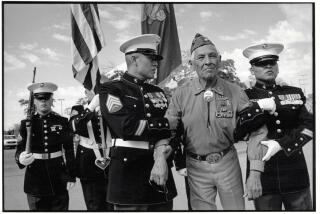46 YEARS IN STORAGE : Hearst’s Indian Rugs Finally Get a Show
- Share via
The Hearst Castle is anyone’s fantasy of a, fairy-tale palace, filled with Flemish tapestries, Italian marble mantles and Austrian candelabra. But one biographer has it that William Randolph Hearst visualized his baroque fortress as a showcase for something inimitably American.
According to writer Fremont Older, the publishing tycoon told his architect to design “cool, spacious buildings with tile floors where I can display my large collection of Indian rugs.”
Hearst amassed 200 hand-woven Navajo textiles between 1900 and 1930, but they never made it into the San Simeon landmark, nor were they ever displayed anywhere else. Until now.
In 1942, he donated the handsome weavings to the Natural History Museum of Los Angeles County, which has finally placed 75 of them on exhibit. “Art From the Navajo Loom: The William Randolph Hearst Collection” runs through Sept. 5.
Nancy Blomberg, who curated the show, says the Exposition Park museum waited 46 years to stage the exhibit because, “we never had the curatorial expertise or interest.” But when Blomberg became assistant curator of anthropology in the late ‘70s, she immediately set to work studying the collection.
Hearst, known for indiscriminate taste in antiquities, “really knew what he was doing” when it came to Navajo weavings, said Blomberg during a recent interview and tour of the exhibit. His comprehensive collection, from a humble brown and white blanket with a simple striped design, to an “eyedazzler” rug with vibrating purple and yellow zigzags, represents almost all the major types of textiles woven between 1800 and 1920 and illuminates much of Navajo cultural evolution.
The bulk of Hearst’s textiles are of the “Classical” period (1650-1868) in Navajo loom weaving. The earliest pieces of the era, the simple striped cotton blankets made to be wrapped around the shoulders, reflect the influence of the Pueblo Indians, who taught the craft to Navajo women, Blomberg said.
However, by the early 19th Century, changes in material, stitching, color and motif began to appear as the Navajo came in contact with Western culture and the Spaniards, who brought sheep--and thus wool weaving--to the Indian tribe.
Zigzags, diamond-shaped and other more elaborate designs appeared, as did a greater variety of garments and hues and brighter colors, made, for instance, from threads of unraveled European cloth.
The “gem” of the collection, a 1865 serape with an intricate, unsymmetrical pattern and Yei, or holy, human-like figures, represents both Spanish and Mexican influence, Blomberg said.
“The design is totally different for the Navajo, who didn’t begin to use Yei figures until the late 19th Century,” she said. “It was common for the Spanish to take Navajo slaves or servants--and vise versa--and this was probably woven by a Navajo slave pleading for help.”
Five years internment by the United States Army later brought about radical, irrevocable changes in Navajo weaving, Blomberg said. This was during the “Transitional” period (1868-1890).
“In captivity, the Navajo had been issued Western clothing and got so used to Velveteen blouses and Western skirts that they began to search for new markets, no longer interested wearing their traditionally woven garments. Also, when they returned to their own reservations, their sheep were gone, so they had to use whatever yarn they could find.”
The results, Blomberg said, included the liberal use of bright, chemically dyed commercial yarns and the proliferation of smaller weavings, such as miniature serapes and 3-by-5 foot “child’s blankets,” often used as saddle blankets. The “new market” was made up mainly of army soldiers, who bought the weavings for easily portable souvenirs or to dress their horses.
By the 1890s, the advent of the railroad, causing an onslaught of tourists and traders, had “changed the market completely,” Blomberg said. “Tourists didn’t want blankets, they wanted big, beautiful rugs” for their Victorian homes, and thus began the so-called “Rug” period, which continues today.
It was during this era that Hearst bought his textiles, 85% from the Fred Harvey Company which set up shop at railroad stations in the Southwest.
Today, the Navajo, most of whom live in Eastern Arizona and Western New Mexico, sell many of their textiles for use as “art objects” for home decoration, and they are as valuable as ever, Blomberg said.
“Prices range from $200 for a small piece by an inexperienced weaver to $20,000” for a larger textile by a seasoned weaver, Blomberg said. She added that $125,000, paid about two years ago, was the most a Navajo textile has ever fetched at auction. “But American cavalry officers would pay $50 for one of these--and that was most of their yearly salary.
“In the 1850s, they were very time-consuming to make,” she explained, adding that from sheep shearing to last stitch effort, it could take a Navajo squaw 400 hours to produce a 3-by-5 foot blanket. “And that didn’t count raising the sheep.”
More to Read
Sign up for The Wild
We’ll help you find the best places to hike, bike and run, as well as the perfect silent spots for meditation and yoga.
You may occasionally receive promotional content from the Los Angeles Times.






